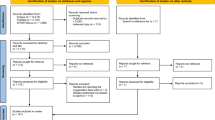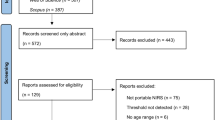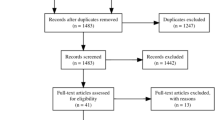Abstract
Background
Since the introduction (in 2006) of commercially available portable wireless muscle oximeters, the use of muscle near-infrared spectroscopy (NIRS) technology is gaining in popularity as an application to observe changes in muscle metabolism and muscle oxygenation during and after exercise or training interventions in both laboratory and applied sports settings.
Objectives
The objectives of this systematic review were to highlight the application of muscle oximetry in evaluating oxidative skeletal muscle performance to sport activities and emphasize how this technology has been applied to exercise and training.
Methods
Preferred Reporting Items for Systematic Reviews and Meta-Analyses guidelines were followed in a systematic fashion to search, assess and synthesize existing literature on this topic. The Scopus and MEDLINE/PubMed electronic databases were searched to 1 March 2017. Potential inclusions were screened against eligibility criteria relating to recreationally trained to elite athletes, with or without training programs, who must have assessed physiological variables monitored by commercial oximeters or NIRS instrumentation.
Results
Of the 14,609 identified records, only 57 studies met the eligibility criteria. This systematic review highlighted a number of key findings in 16 sporting activities. Overall, NIRS information can be used as a marker of skeletal muscle oxidative capacity and for analyzing muscle performance factors.
Conclusions
Although NIRS instrumentation is promising in evaluating oxidative skeletal muscle performance when used in sport settings, there is still the need for further instrumental development and randomized/longitudinal trials to support the detailed advantages of muscle oximetry utilization in sports science.

Similar content being viewed by others
References
McCully KK, Hamaoka T. Near-infrared spectroscopy: what can it tell us about oxygen saturation in skeletal muscle? Exerc Sport Sci Rev. 2000;28(3):123–7.
Ferrari M, Quaresima V. Near infrared brain and muscle oximetry: from the discovery to current applications. J Near Infrared Spectrosc. 2012;20(1):1–14.
Poole DC, Mathieu-Costello O. Skeletal muscle capillary geometry: adaptation to chronic hypoxia. Respir Physiol. 1989;77(1):21–9.
Bendahan D, Chatel B, Jue T. Comparative NMR and NIRS analysis of oxygen dependent metabolism in exercising finger flexor muscles. Am J Physiol Regul Integr Comp Physiol. 2017;. https://doi.org/10.1152/ajpregu.00203.2017 (Epub 6 Sep 2017).
Ferrari M, Muthalib M, Quaresima V. The use of near-infrared spectroscopy in understanding skeletal muscle physiology: recent developments. Philos Trans A. 1955;2011(369):4577–90.
Hamaoka T, McCully KK, Niwayama M, et al. The use of muscle near-infrared spectroscopy in sport, health and medical sciences: recent developments. Philos Trans A. 1955;2011(369):4591–604.
Hamaoka T, McCully KK, Quaresima V, et al. Near-infrared spectroscopy/imaging for monitoring muscle oxygenation and oxidative metabolism in healthy and diseased humans. J Biomed Opt. 2007;12(6):062105.
Grassi B, Quaresima V. Near-infrared spectroscopy and skeletal muscle oxidative function in vivo in health and disease: a review from an exercise physiology perspective. J Biomed Opt. 2016;21(9):091313.
Chance B, Dait MT, Zhang C, et al. Recovery from exercise-induced desaturation in the quadriceps muscles of elite competitive rowers. Am J Physiol. 1992;262(3 Pt 1):C766–75.
Quaresima V, Lepanto R, Ferrari M. The use of near infrared spectroscopy in sports medicine. J Sports Med Phys Fitness. 2003;43(1):1–13.
Neary JP. Application of near infrared spectroscopy to exercise sports science. Can J Appl Physiol. 2004;29(4):488–503.
Bhambhani Y. Application of near infrared spectroscopy in evaluating cerebral and muscle haemodynamics during exercise and sports. J Near Infrared Spectrosc. 2012;20(1):117–39.
Scholkmann F, Kleiser S, Metz AJ, et al. A review on continuous wave functional near-infrared spectroscopy and imaging instrumentation and methodology. Neuroimage. 2014;85(Pt 1):6–27.
Moher D, Liberati A, Tetzlaff J, et al. Preferred reporting items for systematic reviews and meta-analyses: the PRISMA statement. PLoS Med. 2009;6(7):e1000097.
Sperlich B, Born DP, Swarén M, et al. Is leg compression beneficial for alpine skiers? BMC Sports Sci Med Rehabil. 2013;5(1):18.
Fryer S, Stoner L, Scarrott C, et al. Forearm oxygenation and blood flow kinetics during a sustained contraction in multiple ability groups of rock climbers. J Sports Sci. 2015;33(5):518–26.
Fryer S, Stoner L, Stone K, et al. Forearm muscle oxidative capacity index predicts sport rock-climbing performance. Eur J Appl Physiol. 2016;116(8):1479–84.
Fryer SM, Stoner L, Dickson TG, et al. Oxygen recovery kinetics in the forearm flexors of multiple ability groups of rock climbers. J Strength Cond Res. 2015;29(6):1633–9.
Giles D, Romero VE, Garrido I, et al. Differences in oxygenation kinetics between the dominant and nondominant flexor digitorum profundus in rock climbers. Int J Sports Physiol Perform. 2017;12(1):137–9.
Macleod D, Sutherland DL, Buntin L, et al. Physiological determinants of climbing-specific finger endurance and sport rock climbing performance. J Sports Sci. 2007;25(12):1433–43.
Philippe M, Wegst D, Müller T, et al. Climbing-specific finger flexor performance and forearm muscle oxygenation in elite male and female sport climbers. Eur J Appl Physiol. 2012;112(8):2839–47.
Bailey SJ, Vanhatalo A, Black MI, et al. Effects of priming and pacing strategy on oxygen-uptake kinetics and cycling performance. Int J Sports Physiol Perform. 2016;11(4):440–7.
Boone J, Koppo K, Barstow TJ, et al. Effect of exercise protocol on deoxy[Hb + Mb]: incremental step versus ramp exercise. Med Sci Sports Exerc. 2010;42(5):935–42.
Brizendine JT, Ryan TE, Larson RD, et al. Skeletal muscle metabolism in endurance athletes with near-infrared spectroscopy. Med Sci Sports Exerc. 2013;45(5):869–75.
Gendron P, Dufresne P, Laurencelle L, et al. Performance and cycling efficiency after supra-maximal interval training in trained cross-country mountain bikers. Int J Appl Sports Sci. 2016;28(1):19–30.
Faiss R, Léger B, Vesin JM, et al. Significant molecular and systemic adaptations after repeated sprint training in hypoxia. PLoS One. 2013;8(2):e56522.
Hamlin MJ, Marshall HC, Hellemans J, et al. Effect of intermittent hypoxia on muscle and cerebral oxygenation during a 20-km time trial in elite athletes: a preliminary report. Appl Physiol Nutr Metab. 2010;35(4):548–59.
Hopker JG, O’Grady C, Pageaux B. Prolonged constant load cycling exercise is associated with reduced gross efficiency and increased muscle oxygen uptake. Scand J Med Sci Sports. 2017;27(4):408–17.
Iannetta D, Qahtani A, Mattioni Maturana F, et al. The near-infrared spectroscopy-derived deoxygenated haemoglobin breaking-point is a repeatable measure that demarcates exercise intensity domains. J Sci Med Sport. 2017;20(9):873–7.
Racinais S, Buchheit M, Girard O. Breakpoints in ventilation, cerebral and muscle oxygenation, and muscle activity during an incremental cycling exercise. Front Physiol. 2014;5:142.
Skovereng K, Ettema G, van Beekvelt MCP. Oxygenation, local muscle oxygen consumption and joint specific power in cycling: the effect of cadence at a constant external work rate. Eur J Appl Physiol. 2016;116(6):1207–17.
Sperlich B, Zinner C, Pfister R, et al. Repeated apnea-induced contraction of the spleen in cyclists does not enhance performance in a subsequent time-trial. Eur J Appl Physiol. 2015;115(1):205–12.
Vogiatzis I, Athanasopoulos D, Habazettl H, et al. Intercostal muscle blood flow limitation in athletes during maximal exercise. J Physiol. 2009;587(Pt 14):3665–77.
Wittekind A, Cooper CE, Elwell CE, et al. Warm-up effects on muscle oxygenation, metabolism and sprint cycling performance. Eur J Appl Physiol. 2012;112(8):3129–39.
Zorgati H, Collomp K, Boone J, et al. Effect of pedaling cadence on muscle oxygenation during high-intensity cycling until exhaustion: a comparison between untrained subjects and triathletes. Eur J Appl Physiol. 2015;115(12):2681–9.
Brocherie F, Millet GP, Girard O. Neuro-mechanical and metabolic adjustments to the repeated anaerobic sprint test in professional football players. Eur J Appl Physiol. 2015;115(5):891–903.
McLean S, Kerhervé H, Lovell GP, et al. The effect of recovery duration on vastus lateralis oxygenation, heart rate, perceived exertion and time motion descriptors during small sided football games. PLoS One. 2016;11(2):e0150201.
Bieuzen F, Borne R, Toussaint JF, et al. Positive effect of specific low-frequency electrical stimulation during short-term recovery on subsequent high-intensity exercise. Appl Physiol Nutr Metab. 2014;39(2):202–10.
Kounalakis SN, Bayios IA, Koskolou MD, et al. Anaerobic capacity of the upper arms in top-level team handball players. Int J Sports Physiol Perform. 2008;3(3):251–61.
Jones B, Hamilton DK, Cooper CE. Muscle oxygen changes following sprint interval cycling training in elite field hockey players. PLoS One. 2015;10(3):e0120338.
Kujach S, Ziemann E, Grzywacz T, et al. Muscle oxygenation in response to high intensity interval exercises among high trained judokas. Isokinet Exerc Sci. 2016;24(3):263–75.
Dascombe B, Laursen P, Nosaka K, et al. No effect of upper body compression garments in elite flat-water kayakers. Eur J Sport Sci. 2013;13(4):341–9.
Kjeld T, Rasmussen MR, Jattu T, et al. Ischemic preconditioning of one forearm enhances static and dynamic apnea. Med Sci Sports Exerc. 2014;46(1):151–5.
Jones B, Cooper CE. Use of NIRS to assess effect of training on peripheral muscle oxygenation changes in elite rugby players performing repeated supramaximal cycling tests. Adv Exp Med Biol. 2014;812:333–9.
Jones B, Hesford CM, Cooper CE. The use of portable NIRS to measure muscle oxygenation and haemodynamics during a repeated sprint running test. Adv Exp Med Biol. 2013;789:185–91.
Born DP, Stöggl T, Swarén M, et al. Running in hilly terrain: NIRS is more accurate to monitor intensity than heart rate. Int J Sports Physiol Perform. 2017;12(4):440–7.
Buchheit M, Laursen PB, Ahmaidi S. Effect of prior exercise on pulmonary O2 uptake and estimated muscle capillary blood flow kinetics during moderate-intensity field running in men. J Appl Physiol. 2009;107(2):460–70.
Buchheit M, Cormie P, Abbiss CR, et al. Muscle deoxygenation during repeated sprint running: effect of active vs. passive recovery. Int J Sports Med. 2009;30(6):418–25.
Buchheit M, Bishop D, Haydar B, et al. Physiological responses to shuttle repeated-sprint running. Int J Sports Med. 2010;31(6):402–9.
Buchheit M. Performance and physiological responses to repeated-sprint and jump sequences. Eur J Appl Physiol. 2010;110(5):1007–18.
Buchheit M, Ufland P, Haydar B, et al. Reproducibility and sensitivity of muscle reoxygenation and oxygen uptake recovery kinetics following running exercise in the field. Clin Physiol Funct Imaging. 2011;31(5):337–46.
Buchheit M, Haydar B, Hader K, et al. Assessing running economy during field running with changes of direction: application to 20 m shuttle runs. Int J Sports Physiol Perform. 2011;6(3):380–95.
Buchheit M, Ufland P. Effect of endurance training on performance and muscle reoxygenation rate during repeated-sprint running. Eur J Appl Physiol. 2011;111(2):293–301.
Kerhervé HA, Samozino P, Descombe F, et al. Calf compression sleeves change biomechanics but not performance and physiological responses in trail running. Front Physiol. 2017;8:247.
Kitada T, Machida S, Naito H. Influence of muscle fibre composition on muscle oxygenation during maximal running. BMJ Open Sport Exerc Med. 2015;1(1):e000062.
Oueslati F, Boone J, Ahmaidi S. Respiratory muscle endurance, oxygen saturation index in vastus lateralis and performance during heavy exercise. Respir Physiol Neurobiol. 2016;227:41–7.
Stevens CJ, Hacene J, Sculley DV, et al. The reliability of running performance in a 5 km time trial on a non-motorized treadmill. Int J Sports Med. 2015;36(9):705–9.
Ufland P, Ahmaidi S, Buchheit M. Repeated-sprint performance, locomotor profile and muscle oxygen uptake recovery: effect of training background. Int J Sports Med. 2013;34(10):924–30.
Vercruyssen F, Easthope C, Bernard T, et al. The influence of wearing compression stockings on performance indicators and physiological responses following a prolonged trail running exercise. Eur J Sport Sci. 2014;14(2):144–50.
Vogiatzis I, Tzineris D, Athanasopoulos D, et al. Quadriceps oxygenation during isometric exercise in sailing. Int J Sports Med. 2008;29(1):11–5.
Vogiatzis I, Andrianopoulos V, Louvaris Z, et al. Quadriceps muscle blood flow and oxygen availability during repetitive bouts of isometric exercise in simulated sailing. J Sport Sci. 2011;29(10):1041–9.
Born DP, Zinner C, Herlitz B, et al. Muscle oxygenation asymmetry in ice speed skaters: not compensated by compression. Int J Sports Physiol Perform. 2014;9(1):58–67.
Hesford CM, Laing SJ, Cardinale M, et al. Asymmetry of quadriceps muscle oxygenation during elite short-track speed skating. Med Sci Sports Exerc. 2012;44(3):501–8.
Hesford CM, Laing S, Cardinale M, et al. Effect of race distance on muscle oxygenation in short-track speed skating. Adv Exp Med Biol. 2013;45(1):83–92.
Hesford C, Cardinale M, Laing S, et al. NIRS measurements with elite speed skaters: comparison between the ice rink and the laboratory. Adv Exp Med Biol. 2013;765:81–6.
Hettinga FJ, Konings MJ, Cooper CE. Differences in muscle oxygenation, perceived fatigue and recovery between long-track and short-track speed skating. Front Physiol. 2016;7:619.
Faiss R, Willis S, Born DP, et al. Repeated double-poling sprint training in hypoxia by competitive cross-country skiers. Med Sci Sports Exerc. 2015;47(4):809–17.
Hesford CM, Laing S, Cooper CE. Using portable NIRS to compare arm and leg muscle oxygenation during roller skiing in biathletes: a case study. Adv Exp Med Biol. 2013;789:179–84.
Paradis-Deschênes P, Joanisse DR, Billaut F. Ischemic preconditioning increases muscle perfusion, oxygen uptake, and force in strength-trained athletes. Appl Physiol Nutr Metab. 2016;41(9):938–44.
Paradis-Deschênes P, Joanisse DR, Billaut F. Sex-specific impact of ischemic preconditioning on tissue oxygenation and maximal concentric force. Front Physiol. 2017;7:674.
Jones B, Cooper CE. Underwater near-infrared spectroscopy: muscle oxygen changes in the upper and lower extremities in club level swimmers and triathletes. Adv Exp Med Biol. 2016;876:35–40.
Jones B, Dat M, Cooper CE. Underwater near-infrared spectroscopy measurements of muscle oxygenation: laboratory validation and preliminary observations in swimmers and triathletes. J Biomed Opt. 2014;19:127002.
Southern WM, Ryan TE, Reynolds MA, et al. Reproducibility of near-infrared spectroscopy measurements of oxidative function and postexercise recovery kinetics in the medial gastrocnemius muscle. Appl Physiol Nutr Metab. 2014;39(5):521–9.
Hamaoka T, Iwane H, Shimomitsu T, et al. Noninvasive measures of oxidative metabolism on working human muscles by near-infrared spectroscopy. J Appl Physiol. 1996;81(3):1410–7.
Ryan TE, Brophy P, Lin CT, et al. Assessment of in vivo skeletal muscle mitochondrial respiratory capacity in humans by near-infrared spectroscopy: a comparison with in situ measurements. J Physiol. 2014;592:3231–41.
Bhambhani YM, Buckley SM, Susaki T. Detection of ventilatory threshold using near infrared spectroscopy in men and women. Med Sci Sports Exerc. 1997;29:402–9.
Denis R, Bringard A, Perrey S. Vastus lateralis oxygenation dynamics during maximal fatiguing concentric and eccentric isokinetic muscle actions. J Electromyogr Kinesiol. 2011;21(2):276–82.
Partsch H, Mosti G. Comparison of three portable instruments to measure compression pressure. Int Angiol. 2010;29(5):426–30.
Cardinale M, Varley MC. Wearable training-monitoring technology: applications, challenges, and opportunities. Int J Sports Physiol Perform. 2017;12(Suppl 2):S255–62.
Koga S, Rossiter HB, Heinonen I, et al. Dynamic heterogeneity of exercising muscle blood flow and O2 utilization. Med Sci Sports Exerc. 2014;46(456):860–76.
Vogiatzis I, Habazettl H, Louvaris Z, et al. A method for assessing heterogeneity of blood flow and metabolism in exercising normal human muscle by near-infrared spectroscopy. J Appl Physiol. 2015;118(6):783–93.
Crum EM, O’Connor WJ, Van Loo L, et al. Validity and reliability of the Moxy oxygen monitor during incremental cycling exercise. Eur J Sport Sci. 2017;17(8):1037–43.
Benni PB, MacLeod Ikeda K, et al. A validation method for near-infrared spectroscopy based tissue oximeters for cerebral and somatic tissue oxygen saturation measurements. J Clin Monit Comput. 2017;. https://doi.org/10.1007/s10877-017-0015-1 (epub 3 Apr 2017).
Niemeijer VM, Spee RF, Jansen JP, et al. Test-retest reliability of skeletal muscle oxygenation measurements during submaximal cycling exercise in patients with chronic heart failure. Clin Physiol Funct Imaging. 2017;37(1):68–78.
Scott BR, Slattery KM, Sculley DV, et al. Reliability of telemetric electromyography and near-infrared spectroscopy during high-intensity resistance exercise. J Electromyogr Kinesiol. 2014;24(5):722–30.
Niemeijer VM, Jansen JP, van Dijk T, et al. The influence of adipose tissue on spatially resolved near-infrared spectroscopy derived skeletal muscle oxygenation: the extent of the problem. Physiol Meas. 2017;38(3):539–54.
Borges NR, Driller MW. Wearable lactate threshold predicting device is valid and reliable in runners. J Strength Cond Res. 2016;30(8):2212–8.
Quaresima V, Ferrari M. Functional near-infrared spectroscopy (fNIRS) for assessing cerebral cortex function during human behavior in natural/social situations: a concise review. Organ Res Methods. 2016;. https://doi.org/10.1177/1094428116658959 (epub 18 Jul 2016).
Hu G, Zhang Q, Ivkovic V, et al. Ambulatory diffuse optical tomography and multimodality physiological monitoring system for muscle and exercise applications. J Biomed Opt. 2016;21(9):091314.
Shang Y, Li T, Yu G. Clinical applications of near-infrared diffuse correlation spectroscopy and tomography for tissue blood flow monitoring and imaging. Physiol Meas. 2017;38(4):R1–26.
Acknowledgements
The authors would like to thank Rosanna De Carolis for technical support.
Author information
Authors and Affiliations
Contributions
Stephane Perrey and Marco Ferrari contributed to the planning, literature appraisal and writing of the review, and read and approved the final version submitted for publication.
Corresponding author
Ethics declarations
Conflicts of Interest
Stephane Perrey and Marco Ferrari declare that they have no conflicts of interest relevant to the content of this review.
Funding
No sources of funding were used to assist in the study design; collection, analysis and interpretation of data; or writing of this article.
Rights and permissions
About this article
Cite this article
Perrey, S., Ferrari, M. Muscle Oximetry in Sports Science: A Systematic Review. Sports Med 48, 597–616 (2018). https://doi.org/10.1007/s40279-017-0820-1
Published:
Issue Date:
DOI: https://doi.org/10.1007/s40279-017-0820-1




